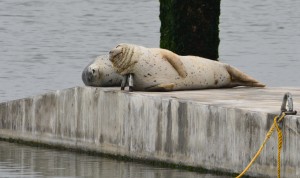By Richard Bangert
 A new cement float for harbor seals was delivered to Alameda Point on June 22. It is the first float of its kind on the West Coast. With seals starting to use the new platform, a milestone has been reached culminating two-and-a-half years of citizen advocacy to maintain a resting site for harbor seals at Alameda Point. A ferry maintenance facility is slated to begin construction this summer at the site where the seals have been finding solitude for over a decade. The new float will soon be anchored 100 yards away from their old haunt.
A new cement float for harbor seals was delivered to Alameda Point on June 22. It is the first float of its kind on the West Coast. With seals starting to use the new platform, a milestone has been reached culminating two-and-a-half years of citizen advocacy to maintain a resting site for harbor seals at Alameda Point. A ferry maintenance facility is slated to begin construction this summer at the site where the seals have been finding solitude for over a decade. The new float will soon be anchored 100 yards away from their old haunt.
The Water Emergency Transportation Authority’s (WETA’s) environmental impact study for its new ferry facility at Alameda’s Inner Bay Harbor overlooked the significance to the seals of an old wooden dock left behind by Navy. Site visits by the consultant conducting the environmental study took place at a time of year and time of day when the seals are rarely seen out of the water (“hauled out”). When WETA was alerted to the harbor-seal issue in January of 2014, it sought review by the National Marine Fisheries Service, which administers the Marine Mammal Protection Act.
The National Marine Fisheries Service ultimately ruled that the seals were not threatened and could find somewhere else to rest. But although Breakwater Island at Alameda Point has been used by seals in the past, ongoing observations by local seal advocates revealed that the seals only haul out on the breakwater at low tide and have rarely chosen the breakwater over the old dock. The new floating haul out, on the other hand, will provide a resting platform throughout the tide cycle.
Despite the fact that the National Marine Fisheries Service did not require a new haul out or mitigation payments, WETA nevertheless committed $100,000 for the harbor seals. Following approval of a 60-year lease for its maintenance facility, WETA and the city secured the services of Dr. Jim Harvey, director of the Moss Landing Marine Laboratories, to provide expert advice on the location and design of the float. Dr. Harvey recommended a location near the old dock in order to stay within the seals’ known comfort zone. He said that ferries moving about nearby would not alarm the seals.
Harbor seals are found in coastal and estuarine waters from Baja California to the Gulf of Alaska and Bering Sea. The only other floating haul-outs used by harbor seals are floating ice in the far north, log booms in Puget Sound, and oyster- and salmon-net pens located in Quilcene Bay within Washington State’s Hood Canal. Harbor seals do not migrate, and once they take a liking to a haul-out site they become regulars — a behavior known as “site fidelity.”
During the winter months at Alameda Point, it was not uncommon to see two dozen seals hauled out on the old wooden dock and some odd planks tied to the dock pilings. The inner harbor at Alameda Point is the only harbor seal haul-out site in the East Bay between Yerba Buena Island and Fremont. The sheltered harbor with good food foraging makes the area ideal for seals. When they come out of the water to warm up and molt, they are extremely vulnerable to human disturbance, unlike their marine mammal cousins the sea lion.
The new float is 20 feet by 25 feet. It was initially anchored next to the old dock, which was demolished on July 11. The float will gradually be moved to the permanent location. Once anchored, the new float will be 100 yards from the shoreline and Bay Trail.
The float is made of reinforced concrete. Styrofoam enclosed within the concrete keeps the platform afloat. It will be held in place at its permanent location with four anchors. One side is sloped to make it easier for the seals to haul out. This custom-designed structure was built by Kie Con Inc. in Antioch at a cost to WETA of $68,000.
The effort to create a new haul out for seals in Alameda’s Inner Bay Harbor was supported by the Sierra Club, including national executive director Michael Brune, who wrote a letter of support. The Golden Gate Audubon Society also supported the effort. Local activists launched an international petition in 2014, gathering 3,000 signatures.
The success of this constructed habitat suggests an option for helping Bay Area harbor seals when traditional natural habitat used by seals, such as Mowry and Newark Sloughs, becomes inundated by sea level rise.
WhatYouCanDo
You can volunteer as a harbor-seal monitor, sending in reports of seal observations when you visit the Bay Trail. To get involved, email alamedaharborseals@gmail.com. You can also follow the Alameda Point Harbor Seal Monitors Facebook page.